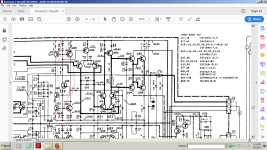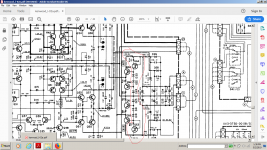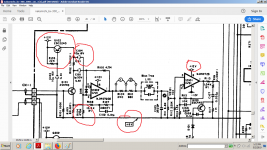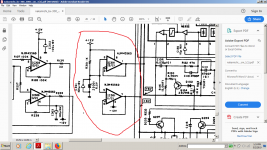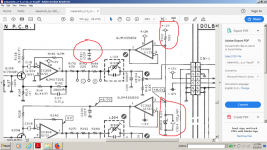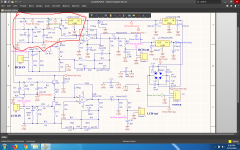I'm looking for a low noise 18V and -18V linear voltage regulator.
I found these:
MC7918 -> 110μV
MC7818 -> 10μV
LT3015 -> 60μV
LT1969A -> 40μV
Also found the TPS series and there are couple of "three legs" prebuilt version from them.
You guys know any better? Or is it doesn't matter at all in an amplifier PSU?
I found these:
MC7918 -> 110μV
MC7818 -> 10μV
LT3015 -> 60μV
LT1969A -> 40μV
Also found the TPS series and there are couple of "three legs" prebuilt version from them.
You guys know any better? Or is it doesn't matter at all in an amplifier PSU?
... know any better?...
LT3042 <1 uV (!)
Whether it matters depends on your application.
Best wishes
David
Do you have an amplifier with some noticeable 'noise'?
Have you seen quality amplifiers with standard linear voltage regulators?
My concern is that you may be needlessly enquiring about an aspect of amplifier design that has no relation to amplifier performance. It is also worthwhile using descriptions such as 'ultra' with care, as they likely mean something very different to just a common lower noise variant of a popular linear regulator.
Have you seen quality amplifiers with standard linear voltage regulators?
My concern is that you may be needlessly enquiring about an aspect of amplifier design that has no relation to amplifier performance. It is also worthwhile using descriptions such as 'ultra' with care, as they likely mean something very different to just a common lower noise variant of a popular linear regulator.
You do not write if it is for a power amplifier or a pre-amplifier.
Ultra low noise is important for certain measuring circuits. Depending on your DAC construction it is to play safe.
Low noise (standard) regulators I use for pre-amplifiers. The OP-AMPS I use normally handle noise problems with their PSRR.
For power amplifiers you will hardly notice the difference. And be aware, the very impressive noise data for certain regulators is with a noiseless input voltage and a static load. With an unregulated input voltage and in particular a rapidly varying dynamic load (power amplifier) the noise figures are severely deteriorated in practice.
Ultra low noise is important for certain measuring circuits. Depending on your DAC construction it is to play safe.
Low noise (standard) regulators I use for pre-amplifiers. The OP-AMPS I use normally handle noise problems with their PSRR.
For power amplifiers you will hardly notice the difference. And be aware, the very impressive noise data for certain regulators is with a noiseless input voltage and a static load. With an unregulated input voltage and in particular a rapidly varying dynamic load (power amplifier) the noise figures are severely deteriorated in practice.
Sorry I wasn't clear at all.
I'm building a linear power supply with multiple outputs to feed my phono, dac and turntable etc... For sure for turntable almost doesn't matter.
I'm already feeding my phono as it needs AC power, the converter and the regulator is inside the phono.
I was trying to design the regulator part, but couldn't find any TO220 type low noise regulator.
Currently my phono has the KA7918 and the L7818CV, but I'm sure I can do it better. All the parts caps/opamps etc was the cheapest ones in the phono, so I think maybe worth to upgrade this as well.
I'm building a linear power supply with multiple outputs to feed my phono, dac and turntable etc... For sure for turntable almost doesn't matter.
I'm already feeding my phono as it needs AC power, the converter and the regulator is inside the phono.
I was trying to design the regulator part, but couldn't find any TO220 type low noise regulator.
Currently my phono has the KA7918 and the L7818CV, but I'm sure I can do it better. All the parts caps/opamps etc was the cheapest ones in the phono, so I think maybe worth to upgrade this as well.
MC7818 -> 10μV ? It sounds too good to be true. May I ask where you read the spec?
Sorry it is not true. I'm not sure where is that information coming from, but double checked it and seem 110µV/Vo
Yes. 78L18 and 79L18 is better .Sorry I wasn't clear at all.
I'm building a linear power supply with multiple outputs to feed my phono, dac and turntable etc... For sure for turntable almost doesn't matter.
I'm already feeding my phono as it needs AC power, the converter and the regulator is inside the phono.
I was trying to design the regulator part, but couldn't find any TO220 type low noise regulator.
Currently my phono has the KA7918 and the L7818CV, but I'm sure I can do it better. All the parts caps/opamps etc was the cheapest ones in the phono, so I think maybe worth to upgrade this as well.
There's a simple technique used to make lower noise regulators with these parts.First you load it externally with a resistor that equals at least the minimum current for which you have the best results in the datasheet.Depending on the current you need you can increase that load up to the same value of the current taken by the circuit or at least half of it or the idle current through the electronic load you need to supply.You need to make some loading adjustments due to the thermal regime so nothing is very clear about that.
This technique is also used in some interesting capacitance multipliers like the one present in Audio note dac 4.
Yes. 78L18 and 79L18 is better .
There's a simple technique used to make lower noise regulators with these parts.First you load it externally with a resistor that equals at least the minimum current for which you have the best results in the datasheet.Depending on the current you need you can increase that load up to the same value of the current taken by the circuit or at least half of it or the idle current through the electronic load you need to supply.You need to make some loading adjustments due to the thermal regime so nothing is very clear about that.
This technique is also used in some interesting capacitance multipliers like the one present in Audio note dac 4.
This is very useful thanks!
But I don't understand why 78L18 and 79L18 better than LT1963 and LT3015?
ON-Semi: 7818 is specified to 110uV (typ.). Sometimes the specifications are a little more tricky like 10uV/Vo which I understand to mean 10uV per volt at the output.
Anyway, you can define low-noise and ultra low-noise as you like. For me, low-noise is around 100uV and ultra low-noise a couple of uV or less.
You have:
1) a "phono" (phono amplifier I assume), 2) a DAC, 3) turntable (motor drive I assume), 4) "etc." (a pre-amplifier I assume).
1) Phono. At present not an issue but perhaps later. A rather static load that may be sensitive to noise. Use an ultra low-noise regulator if possible, else a low-noise regulator. I'm not sure you will notice the difference.
2) DAC. That depends on if it is a finished DAC in a housing usually feed with a standard DC adapter (typically SMPS). Such, often includes a capacitor charge-pump inside that adds noise to any ultra low-noise supply you give it. For such, no need for anything better than a standard low-noise regulator.
If it is a USB feed board the same reasoning apply. Only for high quality boards, it is worth looking for an ultra low noise regulator. It depends fully on how the board is designed.
3) Turntable. You said it yourself, any standard voltage regulator will do.
4) "Etc.". Only discrete and very delicate pre-amplifier designs need better than a standard low-noise regulator. An ultra low-noise regulator will also work but you will hardly notice the difference.
Today we can get ICs with very impressive noise specs. Only if used right, you will benefit from such low noise. And, in most cases you will hardly notice the difference to a normal low-noise regulator.The inconveniences of ultra low-noise regulators are they are typically expensive, with limited output current, more difficult to find/buy and delivered in housings which are inconvenient in normal handling. Conclusion: only use ultra low-noise regulators if you really need them.
NB: I agree with dotneck335.
Anyway, you can define low-noise and ultra low-noise as you like. For me, low-noise is around 100uV and ultra low-noise a couple of uV or less.
You have:
1) a "phono" (phono amplifier I assume), 2) a DAC, 3) turntable (motor drive I assume), 4) "etc." (a pre-amplifier I assume).
1) Phono. At present not an issue but perhaps later. A rather static load that may be sensitive to noise. Use an ultra low-noise regulator if possible, else a low-noise regulator. I'm not sure you will notice the difference.
2) DAC. That depends on if it is a finished DAC in a housing usually feed with a standard DC adapter (typically SMPS). Such, often includes a capacitor charge-pump inside that adds noise to any ultra low-noise supply you give it. For such, no need for anything better than a standard low-noise regulator.
If it is a USB feed board the same reasoning apply. Only for high quality boards, it is worth looking for an ultra low noise regulator. It depends fully on how the board is designed.
3) Turntable. You said it yourself, any standard voltage regulator will do.
4) "Etc.". Only discrete and very delicate pre-amplifier designs need better than a standard low-noise regulator. An ultra low-noise regulator will also work but you will hardly notice the difference.
Today we can get ICs with very impressive noise specs. Only if used right, you will benefit from such low noise. And, in most cases you will hardly notice the difference to a normal low-noise regulator.The inconveniences of ultra low-noise regulators are they are typically expensive, with limited output current, more difficult to find/buy and delivered in housings which are inconvenient in normal handling. Conclusion: only use ultra low-noise regulators if you really need them.
NB: I agree with dotneck335.
I only quoted your last post...but they might be cheaper than the LT parts and still good enough for the job.What's your phono preamp schematic?
Sorry I don't have schematic, it's a Cambridge CP1. Is there any specific question maybe what I can check?
One thing to keep in mind is that some types of amplifier circuits have a lot of power supply rejection, and some types of amplifiers do not. For example, if your preamp is based on conventional monolithic op amp circuitry (i.e. typical 5532 and TL072 type amps), then the amplifier stages will have a very large amount of power supply rejection, at least 40dB and maybe as much as 60dB or more even around 20kHz. So, a power supply regulator that produces 100µV of output noise (-80dBV) through that 40dB of PSRR will result in a noise level of -120dBV at the op amp output - a value that will likely be swamped by other noise sources in the preamp.
The reason for this power supply rejection is that integrated circuit op amps use current sources to bias the internal gain stages, and not simple resistors, so they inherently reject voltage variations present on the power supply rails.
However, a classic discrete amplifier circuit will use resistors to bias the stages, and these resistors will efficiently couple 'signals' on the power supply rails to the amplifier output. This means that the power supply rejection ratio of a discrete circuit could be only a handful of dB, essentially no attenuation from supply rail to output. So, for those circuits, quieter (and lower impedance) regulators will provide meaningful improvements.
So, while it's interesting to use low noise regulators, whether it will have any "end of the day" noise benefits will depend on the circuit that it powers. I use low noise regulators in some designs I'm working on, but primarily because these regulators also have low broadband impedance, something that usually goes hand in hand with low noise regulators.
The reason for this power supply rejection is that integrated circuit op amps use current sources to bias the internal gain stages, and not simple resistors, so they inherently reject voltage variations present on the power supply rails.
However, a classic discrete amplifier circuit will use resistors to bias the stages, and these resistors will efficiently couple 'signals' on the power supply rails to the amplifier output. This means that the power supply rejection ratio of a discrete circuit could be only a handful of dB, essentially no attenuation from supply rail to output. So, for those circuits, quieter (and lower impedance) regulators will provide meaningful improvements.
So, while it's interesting to use low noise regulators, whether it will have any "end of the day" noise benefits will depend on the circuit that it powers. I use low noise regulators in some designs I'm working on, but primarily because these regulators also have low broadband impedance, something that usually goes hand in hand with low noise regulators.
Would you say, then, that "a classic discrete amplifier circuit " as used in a POWER amplifier will benefit greatly from a regulated high voltage/current supply?One thing to keep in mind is that some types of amplifier circuits have a lot of power supply rejection, and some types of amplifiers do not.
However, a classic discrete amplifier circuit will use resistors to bias the stages, and these resistors will efficiently couple 'signals' on the power supply rails to the amplifier output. This means that the power supply rejection ratio of a discrete circuit could be only a handful of dB, essentially no attenuation from supply rail to output. So, for those circuits, quieter (and lower impedance) regulators will provide meaningful improvements.
I always look for the regulator with the minimum current for the job.So if your op-amp needs 20ma at max power i would consider 4x current need and 78L15 with its 100ma would be ok, but then you need to see what's the voltage to be regulated so that you won't exceed the thermal regime for the part...Just simple calculations is all you need.Sorry I don't have schematic, it's a Cambridge CP1. Is there any specific question maybe what I can check?
Here are all the techniques learned from the masters that i use in everything that needs to be low noise:However, a classic discrete amplifier circuit will use resistors to bias the stages, and these resistors will efficiently couple 'signals' on the power supply rails to the amplifier output.
.
1.At high power supply use a bf256 as current source for a 6v2(5v6) Zenner(zero tempco) in series with a suitable diode to make thermal compensation of the ccs if it's the case.This simple technique is used in some of the best phono preamps, including kenwood l-02a which i talked about many times and you have it attached.
2.you can inject strategically some noise in the circuit so that it cancels the common mode and you have an idea in nakamichi bx300 tape head preaamp.
3.You can introduce the j-fet ccs used in Kenwood to improve the psrr of the op-amps reference in Nakamichi .
4.See also how they made the virtual ground(6v ) in Nakamichi bx300.Better opamps could do it for modern electronics.Tape cassettes don't need huge slew rates.
5.See the simplest capacitance multiplier at work in one of the lowest noise circuit ever made for audio, the same nakamichi bx300.Its output impedance at high freq can be improved with higher hfe or darlington transistors loaded with a resistor to ground in each base of each transistors and the final emitter as AudioNote dac 4 did it.Some chokes might be needed too in the transistor bases.
You can use a 78lxx in series with a capacitor multiplier as in the last photo.It's where i broke my first rule of additional loading of the 78lxx with a resistor for at least 5ma as in the datasheet, or better with half the current taken by the regulated circuit.
6.you can use a common mode choke where ever it is possible...
NOW: if i only use op-amps with high psrr and cmrr for a low noise preamps i only use a 4.7, 10, 22...47ohms resistor(depending on the load current) series with 220uf...470uf capacitor(usually i use the most infamous panasonic fc used and reused and taken from scraped industrial electronics, but if i have the opportunity of using better capacitors i won't refuse it.
Attachments
Last edited:
Would you say, then, that "a classic discrete amplifier circuit " as used in a POWER amplifier will benefit greatly from a regulated high voltage/current supply?
Assume a typical three stage amplifier: input stage, voltage gain stage and current buffer stage with overall feedback around all stages. The last stage is after the gain of the first two stages, and it is under feedback, so any power supply gain of that stage will be reduced by the loop feedback around that stage.
The first stage's power supply gain will not be reduced or increased by the gain of the other stages, so this is a place where a low noise power supply will be useful. Still, if the first stage is a differential stage loaded into current sources or current mirrors, it will have some built-in power supply rejection, but other designs may not, so the overall benefit is still dependent on the specific design.
A typical voltage amplifier stage used for a second stage will likely have little or no power supply rejection, but it will be under feedback from the first stage. This means that the first stage gain, probably 10-30dB, will reduce the second stage's power supply gain according to the gain of the first stage.
Given this, a good choice is to use a high performance regulator for the first and possibly the second stage, and leave the final current buffer stage powered by an unregulated but filtered supply. Since the first and second stage current requirements are low, it is much easier to regulate only the low current voltage gain stages, and not the final current buffer stage.
Of course, the final current buffer stage will benefit from regulation, but to a lesser degree, and with the added expense of additional power dissipation and probably a doubling of output pass transistors. So, the greatest benefit will be to regulate the lower current voltage gain stages, and rely on loop gain and feedback to reduce the sensitivity of the current buffer stage to power supply noise.
- Status
- This old topic is closed. If you want to reopen this topic, contact a moderator using the "Report Post" button.
- Home
- Amplifiers
- Power Supplies
- ultra low noise regulators

